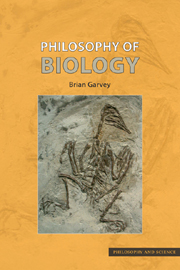Book contents
- Frontmatter
- Contents
- Acknowledgements
- Introduction
- 1 The argument in Darwin's Origin
- 2 The power of genes
- 3 Units of selection
- 4 Panglossianism and its discontents
- 5 The role of development
- 6 Nature and nurture
- 7 Function: “what it is for” versus “what it does”
- 8 Biological categories
- 9 Species and their special problems
- 10 Biology and philosophy of science
- 11 Evolution and epistemology
- 12 Evolution and religion
- 13 Evolution and human nature
- 14 Biology and ethics
- Notes
- Further reading
- Bibliography
- Index
9 - Species and their special problems
- Frontmatter
- Contents
- Acknowledgements
- Introduction
- 1 The argument in Darwin's Origin
- 2 The power of genes
- 3 Units of selection
- 4 Panglossianism and its discontents
- 5 The role of development
- 6 Nature and nurture
- 7 Function: “what it is for” versus “what it does”
- 8 Biological categories
- 9 Species and their special problems
- 10 Biology and philosophy of science
- 11 Evolution and epistemology
- 12 Evolution and religion
- 13 Evolution and human nature
- 14 Biology and ethics
- Notes
- Further reading
- Bibliography
- Index
Summary
As I mentioned in Chapter 8, the creators of the admirable Tree of Life internet project have not bothered with ranking terms such as phylum, class and so on. That, in my view, is one of the reasons why it is admirable. However, they do retain the ranking term “species”. Why do biologists who think that it does not matter whether a group is a phylum or not think it does matter whether a group is a species or not?
The word “species” has a historic resonance. Entities of all kinds fall into nested categories: gold is a metal and a chemical element; “3” is a natural number, an integer, a rational number and a real number. (Admittedly, the chemical tree is nowhere near as profuse as the tree of life; there are only a hundred-odd elements after all.) It would be correct to say that you are a human, a primate, a mammal, a tetrapod, a chordate, a deuterostome, an animal, a eukaryote and a living thing. (I have left out some categories in between.) But, by longstanding tradition, when we say what species something belongs to, we are saying what it is. Aristotelian essences are connected differently to species than to other levels of classification. For Aristotle, to say what species something is, is to give its essence: “essence will only belong to species of a genus, and to nothing else” (Metaphysics Z, 1030a13).
- Type
- Chapter
- Information
- Philosophy of Biology , pp. 143 - 156Publisher: Acumen PublishingPrint publication year: 2007



